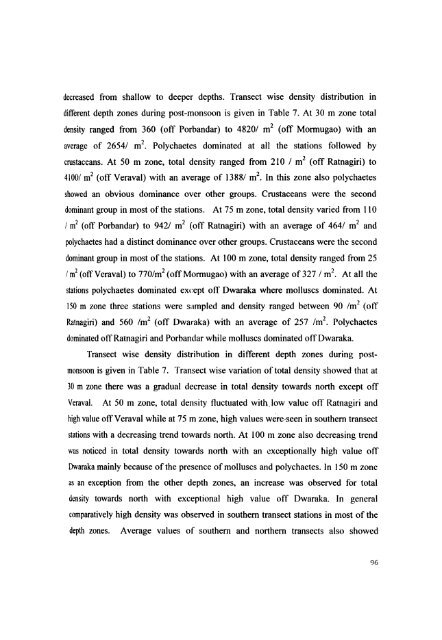L - Cochin University of Science and Technology
L - Cochin University of Science and Technology
L - Cochin University of Science and Technology
Create successful ePaper yourself
Turn your PDF publications into a flip-book with our unique Google optimized e-Paper software.
decreased from shallow to deeper depths. Transect Wlse density distribution in<br />
different depth zones during post-monsoon is given in Table 7. At 30 m zone total<br />
density ranged from 360 (<strong>of</strong>f Porb<strong>and</strong>ar) to 48201 m 2 (<strong>of</strong>f Mormugao) with an<br />
average <strong>of</strong> 26541 m 2 • Polychaetes dominated at all the stations followed by<br />
crustaceans. At 50 m zone, total density ranged from 210 I m 2 (<strong>of</strong>f Ratnagiri) to<br />
41001 m 2 (<strong>of</strong>f Veraval) with an average <strong>of</strong> 13881 m 2 • In this zone also polychaetes<br />
showed an obvious dominance over other groups. Crustaceans were the second<br />
dominant group in most <strong>of</strong> the stations. At 75 m zone, total density varied from 110<br />
/ m 2 (<strong>of</strong>T Porb<strong>and</strong>ar) to 9421 m 2 (<strong>of</strong>f Ratnagiri) with an average <strong>of</strong> 4641 m 2 <strong>and</strong><br />
polychaetes had a distinct dominance over other groups. Crustaceans were the second<br />
dominant group in most <strong>of</strong> the stations. At 100 m zone, total density ranged from 25<br />
/ m 2 (<strong>of</strong>T Veraval) to 770/m 2 (<strong>of</strong>f Monnugao) with an average <strong>of</strong> 327 / m 2 • At all the<br />
stations polychaetes dominated except <strong>of</strong>f Dwaraka where molluscs dominated. At<br />
150 m zone three stations were sampled <strong>and</strong> density ranged between 901m 2 (otT<br />
Ratnagiri) <strong>and</strong> 560 1m2 (<strong>of</strong>f Dwaraka) with an average <strong>of</strong> 257 1m 2 . Polychaetes<br />
dominated <strong>of</strong>f Ratnagiri <strong>and</strong> Porb<strong>and</strong>ar while molluscs dominated <strong>of</strong>f Dwaraka.<br />
Transect wise density distribution in different depth zones during post<br />
monsoon is given in Table 7. Transect wise variation <strong>of</strong> total density showed that at<br />
30 m zone there was a gradual decrease in total density towards north except <strong>of</strong>f<br />
Veraval. At 50 m zone, total density fluctuated with. low value <strong>of</strong>f Ratnagiri <strong>and</strong><br />
high value <strong>of</strong>fVeraval while at 75 m zone, high values were-seen in southern transect<br />
stations with a decreasing trend towards north. At 100 m zone also decreasing trend<br />
was noticed in total density towards north with an exceptionally high value <strong>of</strong>f<br />
Dwaraka mainly because <strong>of</strong> the presence <strong>of</strong> molluscs <strong>and</strong> polychaetes. In 150 m zone<br />
as an exception from the other depth zones, an increase was observed for total<br />
density towards north with exceptional high value <strong>of</strong>f Dwaraka. In general<br />
comparatively high density was observed in southern transect stations in most <strong>of</strong> the<br />
depth zones. Average values <strong>of</strong> southern <strong>and</strong> northern transects also showed<br />
96

















